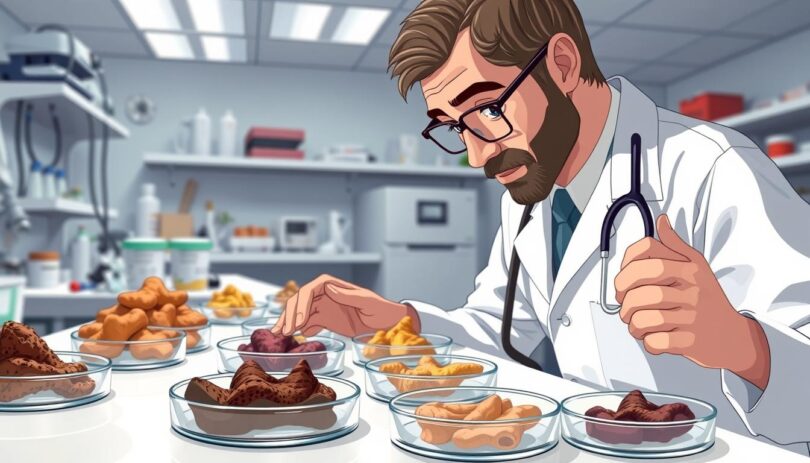What would happen if the way your dog went to the bathroom gave you a clue to underlying health problems? Although most owners pay attention to such obvious signs as vomiting or lethargy, alterations in waste color are usually overlooked, but they may indicate a serious internal issue.
Keeping an eye on the bowel movements of your furry pet is not merely a duty. Small alterations in color or texture may be signs of dietary incompatibility, infection, or organ failure, well before other symptoms are observed. As an example, an abrupt change of brown to bright colors may signify harmless food dye reactions to liver complications.
Understanding these variations helps you act faster. Is it a momentary indignity of table scraps, or something that needs immediate vet attention? This distinction matters. It is easier to get a health snapshot when you see consistency, frequency, and behavior of your pet in addition to color changes.
This guide simplifies the most frequent causes of abnormal waste colors, the red flags to watch out, and when it is necessary to seek professional assessment. The power of knowledge will allow you to take care of the well-being of your four-legged friend without fear.
Monitoring Your Dog’s Health Through Stool Observation
Stool checks are an easy but effective method of pet health monitoring that should be done daily. Although it may be mundane to clean up after your dog, it is important to note what they leave behind as it can give you important information about digestion. Creating a baseline of what is normal will assist the owners to identify deviations early.
The Importance of Regular Checks
Consistency matters more than minor color shifts. A healthy dog poop is usually solid in form and of a chocolate brown color. Noting these details on a daily walk or yard clean up, you establish a baseline of what is normal to your pet.
Texture changes abruptly, such as watery or excessively hard structures, frequently indicate problems prior to the color change. Tracking frequency and appearance weekly helps identify patterns. This practice only takes a few seconds, but it creates awareness about the condition of your dog in the long run.
Noticing Subtle Changes
Minor variations occur naturally due to diet or hydration. Nevertheless, consistent changes in texture and peculiar colors should be noted. As an illustration, diarrhea that persists more than 24 hours may be a sign of gastrointestinal discomfort that requires medical assessment.
Make a mental check list: size, firmness, foreign materials. Compare new deposits to your pet’s typical output. Early detection of abnormalities leads to early treatment, which may prevent expensive treatment in future.
Understanding Normal Dog Poop vs. Yellow Abnormalities
It is necessary to know what to prioritize to distinguish between the common characteristics of waste and alarming changes. A well-functioning digestive system will have certain visual indicators of how well the nutrients are being absorbed and how well the organs are functioning.
Characteristics of Healthy Brown Poop
Optimal digestion creates a chocolate-brown hue in waste. This color is formed when fats are digested in the bile which is a liver secretion. Most of the bile is recycled, but the remaining quantities oxidize and turn dark.
Diet influences shade variations. Meals that are rich in protein can intensify the brown color, whereas diets that are rich in vegetables can make it a little lighter. Uniform texture and log-like shape indicate efficient nutrient processing.
Recognizing Warning Signs in Yellow Stool
Persistent bright or mustard-colored waste often signals incomplete digestion. As opposed to temporary changes in food dyes, persistent coloring of more than two bowel movements is an indication to be investigated. Check for accompanying symptoms like lethargy or appetite changes.
Partial yellow streaks may indicate a fast intestinal transit, whereas complete discoloration of deposits may indicate a problem with the bile flow. Recording such information will assist the veterinarians to evaluate possible liver or pancreatic issues effectively.
The Role of Diet: The Impact of Food Alteration on the Color of Stool
The food that you feed your dog could be telling an unexpected story in their feces. The food that one eats will tend to affect the digestive output more than other factors and so the food choices are one of the areas that one should focus on when there are unusual colors.
Transitioning to New Dog Food Safely
Switching kibble too quickly overwhelms a pet’s digestive system. A gradual 7-10 day transition helps their gut adapt. Begin by adding 25 percent new food to 75 percent of the existing meals, and add more new food to existing meals every two days. This method reduces gastrointestinal stress and minimizes color shifts.
If discoloration occurs during this period, it’s often temporary. It takes the body time to digest unfamiliar proteins or carbohydrates. Any problems lasting longer than three days can be a sign of intolerance as opposed to adjustment.
The Effect of Food Dyes and Treats
Brightly colored snacks frequently contain artificial additives. One chew, dyed yellow, can color waste 12-24 hours. Although they are harmless, these pigments frighten owners because they confuse them with health problems.
To identify triggers, eliminate suspicious treats for 48 hours. Reintroduce each of them individually and observe bowel movements. This procedure helps to elucidate whether the color alterations are the results of dietary peculiarities or some issues which require veterinary care.
Yellow stool in dogs: Uncovering the Root Causes
When the waste of your pet changes to a strange color, it usually indicates that there is something wrong inside the body. There are two major offenders: the way their body processes meals and the dangers lurking in their digestive system.
Indigestion and Food Intolerance Factors
The fast digestion may not allow bile to digest food well. This happens when the body does not accept such ingredients as dairy or some proteins, and they pass through the intestines hastily. The result? Mustard-colored deposits and loose consistency.
Food intolerance triggers an immune response, leading to inflammation. Owners may observe that their pet is straining or passing a lot of watery waste. Tracking meals helps pinpoint problematic foods causing these reactions.
Infections and Digestive Tract Concerns
Harmful organisms like giardia or salmonella disrupt gut balance. These invaders aggravate the intestinal lining, which results in mucus-coated waste and urgency. Symptoms lasting more than 48 hours are likely to be due to infection as opposed to temporary upset.
Parasites cause problems with absorption of nutrients, changing color and texture. Blood tests or fecal exams become essential for diagnosis. The early intervention helps avoid such complications as dehydration or chronic digestive disorders.
Environmental and Behavioral Triggers to Consider
The clues to some of the mysterious changes in digestion may be found in your living room. Daily environments and habits may affect the appearance of waste more than the owners think.
Foreign Object Ingestion Patterns
Pets often explore through chewing. Missing yellow toys or crayons? These items may pass through their system undigested. Art supplies or rubber balls can temporarily color deposits without any imminent threat using non-toxic pigments.
Conduct weekly household scans. Look under furniture to see small items your companion may have swallowed. Seek out such telltale signs as stringy fibers or uneven coloration in waste. Most harmless materials exit naturally within 72 hours.
Stress-Related Digestive Shifts
Anxiety alters gut motility. Digestion may be accelerated by a change of residence or the addition of new pets, which causes waste to be lighter in color. Intense exercise routines might also affect nutrient absorption rates.
Monitor behavior alongside physical symptoms. Panting, pacing, or change of appetite along with abnormal deposits indicate the involvement of stress. Establishing a peaceful environment and making slow changes to the routine can frequently stabilize digestion.
Effective Home Remedies and Dietary Adjustments
Digestive problems can be a pain, but a timely response may be all that is needed. Mild symptoms are usually controlled by simple measures and aid in recovery. Let’s explore practical steps to stabilize your companion’s system.
Implementing a Bland Diet for Digestive Relief
Irritated intestines are given time to reset with a short fasting period. Deny food 12-24 hours, but keep plenty of fresh water. This break allows inflammation to subside naturally.
After fasting, reintroduce meals gradually. Provide boiled chicken or white fish with plain rice in tablespoon quantities 4-6 times a day. These are proteins and carbs that are easily digested, which puts less pressure on the healing digestive pathways.
Using Probiotics and Ensuring Adequate Hydration
Good probiotics re-populate the good intestinal bacteria that are destroyed by the digestive disturbance. Search strains approved by veterinarians such as Bacillus coagulans or Enterococcus faecium that will fight the harmful microbes.
Hydration prevents dehydration during fluid loss. Put low-sodium broth in water bowls or provide ice chips in case your pet does not want to drink. In chronic cases, find safe remedies to diarrhea to balance the electrolytes.
Monitor progress closely. When the symptoms do not disappear within 48 hours after these steps, you should contact your veterinarian to exclude the presence of underlying conditions that need professional treatment.
When to Consult a Veterinarian for Further Evaluation
Veterinary care can help curb small problems before they become severe health problems. Although temporary changes in the digestive system may be solved with home treatment, some patterns require professional knowledge. Being able to know when to switch between observation and action safeguards the health of your pet.
Recognizing Symptoms That Require Immediate Attention
Any discoloration that lasts more than 48 hours should be seen by a vet. More acute symptoms are vomiting, refusal to eat, or lethargy. Such red flags indicate systemic problems that require diagnostics such as bloodwork or imaging.
Document symptom frequency and severity. Take note of whether abnormal deposits are accompanied by changes in medication or scavenging events. This data helps veterinarians pinpoint causes faster.
Preparing to Discuss Concerns with Your Vet
Obtain fresh stool samples with clean gloves and clean containers. Write down the history of your companion including treats or table scraps. Provide information regarding the recent activities such as visiting parks or exposure to new environments.
Vets can order fecal tests to test parasites or infections. For complex cases, ultrasound scans assess organ function. The professional opinions on abnormal waste colors may help you in your discussion, yet never neglect the individual recommendations of your veterinarian.
Final Thoughts on Keeping Your Dog Healthy and Happy
As a pet parent, you have the responsibility of both keeping a watch and preventing. Although some changes in the digestive system are normal, regular observation can be used to identify patterns before they develop into severe conditions. Making a record of what normal should be in your companion gives a baseline with which to identify deviations.
Stick to routine meals and avoid frequent treat changes. Unwanted color changes are likely to be caused by sudden diet changes that tend to disrupt the balance of the gut. Combine this stability with yearly physicals: these screenings identify lurking problems such as pancreatic or intestinal parasites before they get out of hand.
Remember, your observations matter. When deposits become abnormal colors or have streaks of mucus, go with your gut. Immediate response and veterinary advice usually solve small issues and avoid big ones. A proactive approach keeps tails wagging and families thriving.
FAQ
What causes sudden changes in my dog’s stool color?
Color variations are usually caused by dietary changes, food intolerances or consumption of non-food materials. Stool color can be changed by rapid dietary changes, fatty snacks, or food coloring in kibble. It may also be caused by digestive problems such as gallbladder problems or intestinal infections.
How many days after abnormal poop should I wait to call a vet?
Contact a veterinarian in case of unusual coloration lasting longer than 24-48 hours or in combination with such symptoms as vomiting, lethargy, and loss of appetite. Blood-streaked stools, black tarry feces, or severe diarrhea that leads to dehydration should be addressed immediately.
Can certain dog foods turn stool yellow temporarily?
Yes, high-fat diets, pumpkin diets or foods containing yellow/orange dyes (such as found in some kibble brands) can trigger temporary color changes. Check frequency and persistence- normal stool should turn brown again within 1-2 bowel movements once dietary changes are made.










Leave a Comment